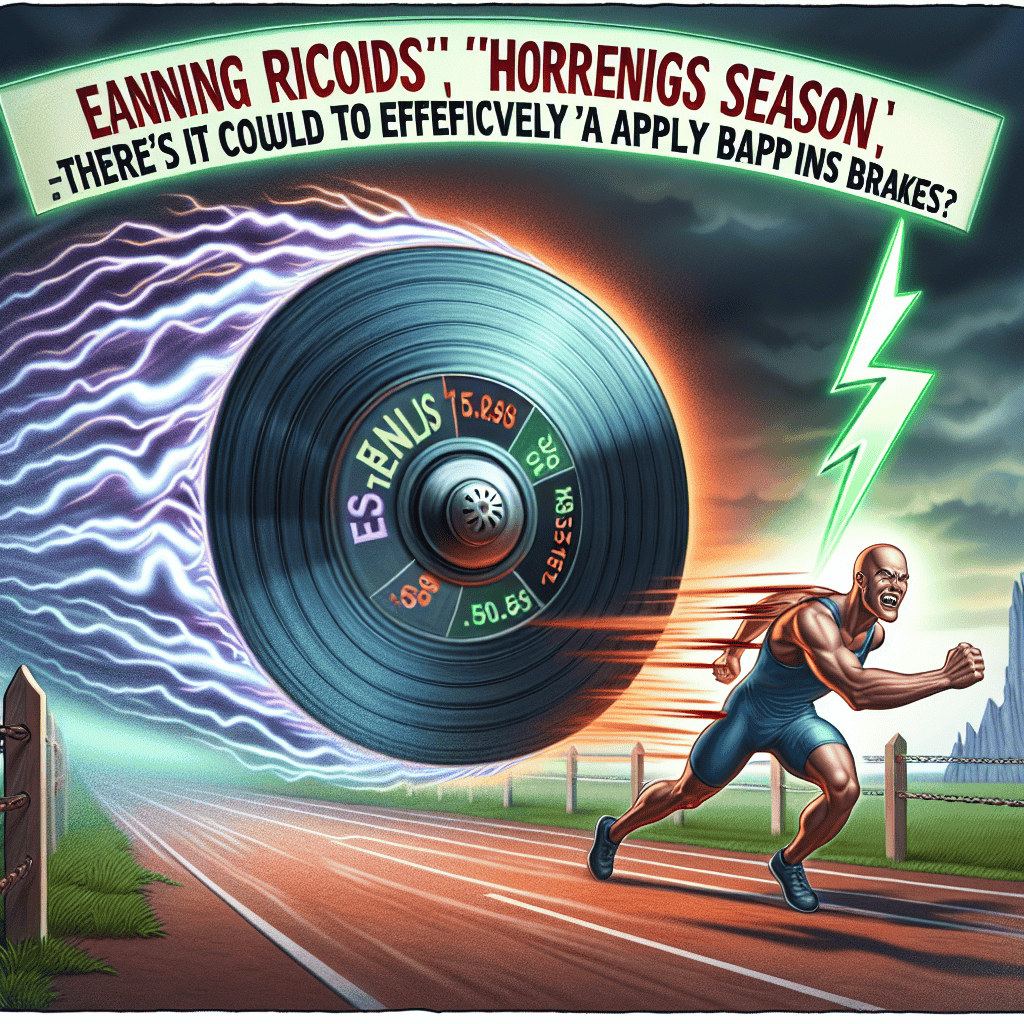“Earnings Surge Ignites Market, But Looming Headwind Threatens to Stall the Rally.”
Introduction
Jim Cramer, the well-known financial analyst and host of CNBC’s “Mad Money,” has recently shared his insights on the current earnings season and its potential impact on the stock market’s ongoing record run. Cramer is optimistic that the earnings reports will continue to drive the market to new heights, as companies reveal strong financial performances and positive outlooks. However, he also cautions investors about a significant headwind that could potentially hinder this rally. Cramer identifies this “horrendous” factor as a looming threat that could apply brakes to the market’s upward momentum, urging investors to remain vigilant and consider the broader economic landscape when making investment decisions.
Jim Cramer’s Insights: Earnings Season’s Impact on Market Records
Jim Cramer, the well-known financial analyst and host of CNBC’s “Mad Money,” has recently shared his insights on the current earnings season and its potential impact on the stock market’s ongoing record run. As investors eagerly anticipate quarterly reports from major corporations, Cramer suggests that the earnings season could serve as a significant catalyst for further market gains. However, he also cautions that a formidable headwind could potentially hinder this upward momentum.
To begin with, Cramer emphasizes the importance of earnings reports in shaping market sentiment. As companies disclose their financial performance, investors gain valuable insights into the health and growth prospects of various sectors. Positive earnings surprises often lead to increased investor confidence, driving stock prices higher. In this context, Cramer believes that strong earnings results could propel the market to new heights, continuing its impressive rally.
Moreover, Cramer points out that the current economic environment is conducive to robust corporate earnings. With consumer spending on the rise and businesses gradually recovering from the pandemic-induced disruptions, many companies are expected to report solid financial results. This optimism is further bolstered by the ongoing support from fiscal and monetary policies, which have provided a favorable backdrop for economic growth. Consequently, Cramer argues that the earnings season could act as a powerful tailwind, pushing the market to unprecedented levels.
However, despite this optimistic outlook, Cramer warns of a significant headwind that could potentially apply brakes to the market’s rally. He identifies inflation as a “horrendous” challenge that investors must not overlook. Rising inflationary pressures have been a growing concern for both policymakers and market participants, as they threaten to erode purchasing power and increase costs for businesses. If inflation continues to accelerate, it could prompt central banks to tighten monetary policy sooner than anticipated, leading to higher interest rates and reduced liquidity in the financial markets.
Cramer further elaborates on the potential implications of inflation for corporate earnings. As input costs rise, companies may face margin pressures, which could ultimately impact their profitability. While some businesses may be able to pass on these costs to consumers through higher prices, others may struggle to maintain their profit margins. This divergence in performance could lead to increased market volatility, as investors reassess their portfolios in light of changing economic conditions.
In addition to inflation, Cramer also highlights other potential risks that could weigh on the market. Geopolitical tensions, supply chain disruptions, and regulatory changes are among the factors that could introduce uncertainty and volatility. As such, he advises investors to remain vigilant and adopt a cautious approach, even as they capitalize on the opportunities presented by the earnings season.
In conclusion, Jim Cramer’s insights underscore the dual nature of the current market environment. On one hand, the earnings season holds the promise of fueling the market’s record run, driven by strong corporate performance and supportive economic conditions. On the other hand, the specter of inflation looms large, posing a significant threat to sustained market gains. As investors navigate this complex landscape, they must weigh the potential rewards against the risks, making informed decisions that align with their financial goals and risk tolerance.
Analyzing Jim Cramer’s Warning: The ‘Horrendous’ Headwind Threat
In the ever-evolving landscape of financial markets, investors often look to seasoned experts for guidance and insights. Jim Cramer, a well-known financial analyst and television personality, recently shared his perspective on the current earnings season and its potential impact on the market’s record-breaking rally. According to Cramer, the earnings season is poised to fuel the market’s upward trajectory, driven by robust corporate performance and investor optimism. However, he also cautioned about a significant headwind that could potentially slow down this momentum.
Cramer’s optimism about the earnings season stems from the strong financial results reported by many companies, which have exceeded analysts’ expectations. This positive trend has been largely attributed to the resilience of businesses in adapting to post-pandemic challenges, coupled with consumer demand that remains robust. As companies continue to report strong earnings, investor confidence is likely to be bolstered, further propelling the market to new heights. The anticipation of continued growth and profitability has created a favorable environment for stocks, encouraging both institutional and retail investors to remain engaged.
Despite this optimistic outlook, Cramer warns of a “horrendous” headwind that could potentially apply brakes to the rally. This headwind is the persistent issue of inflation, which has been a growing concern for both policymakers and market participants. Inflationary pressures have been building due to a combination of factors, including supply chain disruptions, labor shortages, and rising commodity prices. These elements have contributed to increased costs for businesses, which may eventually be passed on to consumers, thereby affecting purchasing power and overall economic growth.
Cramer emphasizes that while the Federal Reserve has taken measures to address inflation, such as adjusting interest rates and tapering asset purchases, the effectiveness of these actions remains uncertain. The central bank’s challenge lies in striking a delicate balance between curbing inflation and sustaining economic growth. If inflation continues to rise unchecked, it could lead to higher borrowing costs and reduced consumer spending, ultimately dampening corporate earnings and investor sentiment.
Moreover, Cramer points out that geopolitical tensions and global economic uncertainties could exacerbate inflationary pressures, further complicating the market outlook. For instance, ongoing trade disputes and energy supply concerns have the potential to disrupt global markets, adding another layer of complexity to the inflation narrative. These factors underscore the importance of vigilance and adaptability for investors navigating the current market environment.
In conclusion, while Jim Cramer acknowledges the positive impact of the earnings season on the market’s record run, he also highlights the significant threat posed by inflation as a potential headwind. Investors are advised to remain cautious and consider the broader economic context when making investment decisions. By staying informed and agile, market participants can better position themselves to navigate the challenges and opportunities that lie ahead. As the financial landscape continues to evolve, the interplay between corporate performance, inflationary pressures, and global dynamics will be crucial in shaping the market’s trajectory.
Earnings Season: Catalyst for Market’s Record Run According to Jim Cramer
Earnings season has long been a pivotal period for investors, offering a window into the financial health and future prospects of publicly traded companies. According to Jim Cramer, the renowned financial analyst and host of CNBC’s “Mad Money,” the upcoming earnings season is poised to act as a significant catalyst for the market’s ongoing record run. Cramer suggests that the robust performance of many companies, driven by strong consumer demand and strategic business adaptations, will likely propel the market to new heights. However, while the earnings reports are expected to provide a much-needed boost, Cramer also cautions investors about a looming headwind that could potentially slow down this rally.
As companies begin to release their quarterly earnings, investors will be keenly observing not only the reported figures but also the guidance provided for future quarters. Cramer emphasizes that positive earnings surprises and optimistic forward-looking statements could inject fresh momentum into the market. This optimism is underpinned by the resilience many companies have shown in navigating supply chain disruptions and inflationary pressures, which have been persistent challenges over the past year. Moreover, sectors such as technology, healthcare, and consumer goods are anticipated to report particularly strong results, further fueling investor confidence.
However, Cramer warns that despite the potential for earnings to drive the market upward, there is a “horrendous” headwind that could apply brakes to this rally: rising interest rates. The Federal Reserve’s monetary policy decisions have a profound impact on market dynamics, and with inflationary pressures still a concern, the possibility of further interest rate hikes looms large. Higher interest rates can increase borrowing costs for companies, potentially dampening their growth prospects and, in turn, affecting their stock valuations. Additionally, rising rates can make fixed-income investments more attractive, potentially drawing capital away from equities.
Cramer advises investors to remain vigilant and consider the implications of monetary policy on their portfolios. While the earnings season may offer a temporary boost, the broader economic environment and central bank actions will play a crucial role in determining the market’s trajectory. Investors should be prepared for potential volatility and consider diversifying their holdings to mitigate risks associated with interest rate fluctuations.
In conclusion, the upcoming earnings season is set to be a critical juncture for the stock market, with the potential to extend its record-breaking run. Jim Cramer’s insights highlight the dual nature of this period: the opportunity presented by strong corporate earnings and the challenge posed by rising interest rates. As investors navigate this complex landscape, they must weigh the positive signals from earnings reports against the broader economic factors that could influence market performance. By staying informed and adopting a strategic approach, investors can better position themselves to capitalize on opportunities while safeguarding against potential headwinds.
Potential Market Brakes: Jim Cramer’s Cautionary Tale

Jim Cramer, the well-known financial analyst and host of CNBC’s “Mad Money,” has recently shared his insights on the current state of the stock market, particularly focusing on the ongoing earnings season. According to Cramer, the earnings season is poised to propel the market to new record highs, driven by robust corporate performances and investor optimism. However, he also cautions that there are significant headwinds that could potentially slow down this rally. As investors navigate these turbulent waters, it is crucial to understand both the opportunities and the risks that lie ahead.
To begin with, Cramer highlights the positive momentum generated by the earnings season. Many companies have reported better-than-expected earnings, which has bolstered investor confidence and contributed to the market’s upward trajectory. This optimism is further fueled by strong consumer spending, technological advancements, and a resilient labor market, all of which have played a pivotal role in driving corporate profits. As a result, the stock market has experienced a surge, with major indices reaching unprecedented levels.
However, despite this promising outlook, Cramer warns of a “horrendous” headwind that could potentially apply brakes to the market’s rally. This headwind comes in the form of rising interest rates, which have been a growing concern for investors. The Federal Reserve’s monetary policy, aimed at curbing inflation, has led to an increase in interest rates, which in turn affects borrowing costs for both consumers and businesses. Higher interest rates can dampen economic growth by making loans more expensive, thereby reducing consumer spending and corporate investments.
Moreover, Cramer points out that the impact of rising interest rates is not limited to the domestic market. Global economic conditions are also influenced by these changes, as higher rates in the United States can lead to capital outflows from emerging markets. This can result in currency depreciation and financial instability in those regions, further complicating the global economic landscape. Consequently, investors must remain vigilant and consider the broader implications of these developments on their portfolios.
In addition to interest rates, Cramer also emphasizes the potential risks posed by geopolitical tensions and supply chain disruptions. Ongoing conflicts and trade disputes can create uncertainty in the market, leading to volatility and fluctuations in stock prices. Furthermore, supply chain issues, exacerbated by the pandemic, continue to pose challenges for companies across various sectors. These disruptions can lead to increased costs and reduced profitability, which may ultimately weigh on the market’s performance.
In light of these factors, Cramer advises investors to adopt a cautious approach. While the earnings season presents opportunities for growth, it is essential to remain aware of the potential headwinds that could hinder the market’s progress. Diversifying investments and staying informed about economic and geopolitical developments can help mitigate risks and ensure a balanced portfolio.
In conclusion, Jim Cramer’s analysis underscores the dual nature of the current market environment. On one hand, the earnings season offers a promising outlook for continued growth and record-breaking performance. On the other hand, rising interest rates, geopolitical tensions, and supply chain disruptions present significant challenges that could slow down the rally. By understanding these dynamics and adopting a strategic approach, investors can navigate the complexities of the market and make informed decisions that align with their financial goals.
Jim Cramer on Market Dynamics: Earnings vs. Headwinds
Jim Cramer, the well-known host of CNBC’s “Mad Money,” has recently shared his insights on the current market dynamics, emphasizing the potential impact of the earnings season on the market’s record run. According to Cramer, the earnings season is poised to act as a significant catalyst, propelling the market to new heights. This optimism is rooted in the anticipation that many companies will report robust earnings, reflecting their resilience and adaptability in an ever-evolving economic landscape. As businesses continue to navigate post-pandemic challenges, their ability to deliver strong financial results could instill confidence among investors, thereby fueling further market gains.
However, while Cramer remains optimistic about the positive influence of the earnings season, he also cautions against complacency. He highlights a “horrendous” headwind that could potentially apply brakes to the ongoing rally. This headwind, as Cramer identifies, is the persistent issue of inflation. Inflationary pressures have been a growing concern for both policymakers and investors alike, as rising prices can erode purchasing power and squeeze profit margins. The Federal Reserve’s monetary policy decisions, aimed at curbing inflation, could lead to higher interest rates, which in turn might dampen economic growth and weigh on market sentiment.
Transitioning from the potential impact of inflation, it is crucial to consider how companies might respond to these economic pressures. Many firms have already begun to implement strategies to mitigate the effects of rising costs, such as streamlining operations, enhancing productivity, and passing on some of the increased costs to consumers. These measures, while necessary, could have varying degrees of success and may not fully offset the challenges posed by inflation. Consequently, investors will need to closely monitor corporate earnings reports for any signs of margin compression or changes in forward guidance.
In addition to inflation, Cramer also points to geopolitical tensions as another factor that could influence market dynamics. The global economic environment remains fraught with uncertainties, ranging from trade disputes to political instability in key regions. These geopolitical risks can create volatility in financial markets, as investors react to news and developments that may impact global supply chains and economic growth prospects. Therefore, while the earnings season may provide a temporary boost to the market, these external factors could introduce an element of unpredictability.
Furthermore, Cramer underscores the importance of investor sentiment in shaping market trends. As earnings reports are released, the market’s reaction will largely depend on whether the results meet, exceed, or fall short of expectations. Positive surprises could lead to a surge in investor confidence, while disappointing outcomes might trigger a reassessment of market valuations. In this context, the role of analysts and their forecasts becomes pivotal, as they help set the benchmark against which corporate performance is measured.
In conclusion, Jim Cramer’s analysis presents a nuanced view of the current market dynamics, balancing optimism about the earnings season with caution regarding potential headwinds. While strong corporate earnings have the potential to drive the market’s record run, investors must remain vigilant in the face of inflationary pressures and geopolitical uncertainties. By staying informed and adaptable, market participants can navigate these challenges and make informed decisions that align with their investment objectives. As the earnings season unfolds, it will be essential to keep a close watch on both macroeconomic indicators and company-specific developments to gain a comprehensive understanding of the market’s trajectory.
The Role of Earnings Season in Market Trends: Jim Cramer’s Perspective
Earnings season is a pivotal period in the financial markets, often serving as a barometer for the health of the economy and the performance of individual companies. Jim Cramer, a well-known financial analyst and television personality, has recently expressed his views on how the upcoming earnings season could influence the market’s current record run. According to Cramer, the earnings reports from major corporations are likely to provide the necessary momentum to sustain the market’s upward trajectory. However, he also cautions investors about a significant headwind that could potentially slow down this rally.
Cramer emphasizes that earnings season offers investors a comprehensive insight into the operational health and future prospects of companies. As firms disclose their quarterly financial results, market participants gain valuable information about revenue growth, profit margins, and strategic initiatives. This transparency allows investors to make informed decisions, potentially driving stock prices higher if the results exceed expectations. Cramer believes that the current economic environment, characterized by robust consumer spending and resilient corporate performance, sets the stage for a strong earnings season. Consequently, he anticipates that positive earnings surprises could fuel the market’s record run, reinforcing investor confidence and encouraging further investment.
However, while Cramer is optimistic about the potential for earnings season to propel the market forward, he also warns of a “horrendous” headwind that could apply brakes to the rally. This headwind, according to Cramer, is the persistent issue of inflation. Rising prices for goods and services have been a growing concern for both consumers and businesses, as inflation erodes purchasing power and increases operational costs. Cramer points out that if inflation continues to accelerate, it could lead to higher interest rates as central banks attempt to curb price pressures. This, in turn, could dampen economic growth and weigh on corporate profits, ultimately impacting stock market performance.
Moreover, Cramer highlights that inflationary pressures are not uniform across all sectors. Some industries, such as technology and healthcare, may be better equipped to manage rising costs due to their pricing power and innovation-driven business models. In contrast, sectors like consumer goods and manufacturing might struggle more with passing on higher costs to consumers, potentially squeezing profit margins. Therefore, Cramer advises investors to be discerning in their stock selections, focusing on companies with strong fundamentals and the ability to navigate inflationary challenges.
In addition to inflation, Cramer also notes other potential risks that could affect the market’s trajectory during earnings season. Geopolitical tensions, supply chain disruptions, and regulatory changes are among the factors that could introduce volatility and uncertainty. As such, he encourages investors to remain vigilant and adaptable, ready to adjust their strategies in response to evolving market conditions.
In conclusion, Jim Cramer’s perspective on the role of earnings season in market trends underscores the dual nature of this critical period. While he is optimistic about the potential for strong corporate earnings to sustain the market’s record run, he also acknowledges the significant headwind posed by inflation. By understanding these dynamics and considering the broader economic context, investors can better navigate the complexities of the market and make informed decisions that align with their financial goals.
Navigating Market Challenges: Jim Cramer’s Advice on Upcoming Headwinds
As the financial markets continue to reach unprecedented heights, investors are keenly observing the factors that could sustain or hinder this momentum. Jim Cramer, a well-known financial analyst and television personality, has recently shared his insights on the current earnings season and its potential impact on the market’s record run. According to Cramer, the earnings season is poised to act as a significant catalyst, propelling the market to new highs. However, he also cautions investors about a looming headwind that could potentially slow down this rally.
Earnings reports are a critical component of market dynamics, providing investors with valuable insights into a company’s financial health and future prospects. Cramer emphasizes that strong earnings results from key sectors could bolster investor confidence, thereby fueling further market gains. Companies that exceed expectations in terms of revenue and profit margins are likely to attract increased investment, driving their stock prices higher. This, in turn, contributes to the overall upward trajectory of the market. Cramer suggests that investors pay close attention to sectors such as technology, healthcare, and consumer goods, as these are expected to deliver robust earnings that could sustain the market’s upward momentum.
However, while the earnings season holds promise, Cramer warns of a “horrendous” headwind that could apply brakes to the rally. This headwind, he notes, is the potential for rising interest rates. As central banks around the world grapple with inflationary pressures, there is growing speculation that interest rates may be increased to curb inflation. Higher interest rates can have a dampening effect on the stock market, as they increase borrowing costs for companies and consumers alike. This can lead to reduced spending and investment, ultimately slowing economic growth and impacting corporate earnings.
Cramer advises investors to remain vigilant and consider the implications of potential interest rate hikes on their portfolios. He suggests that investors diversify their holdings to mitigate risks associated with rising rates. For instance, incorporating bonds or dividend-paying stocks into a portfolio can provide a buffer against market volatility. Additionally, Cramer recommends that investors focus on companies with strong balance sheets and those that have demonstrated resilience in previous economic downturns. These companies are more likely to weather the challenges posed by higher interest rates and continue to deliver value to shareholders.
Furthermore, Cramer highlights the importance of staying informed about macroeconomic indicators and central bank policies. By keeping abreast of developments in these areas, investors can make more informed decisions and adjust their strategies accordingly. He also underscores the value of maintaining a long-term perspective, as short-term market fluctuations are inevitable. By focusing on the fundamentals and maintaining a disciplined approach, investors can navigate the challenges posed by potential headwinds and continue to achieve their financial goals.
In conclusion, while the earnings season presents an opportunity for the market to extend its record run, investors must remain cognizant of the potential headwinds that could arise. Jim Cramer’s insights serve as a valuable guide for navigating these challenges, emphasizing the importance of diversification, resilience, and informed decision-making. By heeding this advice, investors can position themselves to capitalize on opportunities while mitigating risks, ensuring their portfolios remain robust in the face of uncertainty.
Q&A
1. **What does Jim Cramer predict about the earnings season?**
Jim Cramer predicts that the earnings season will fuel the market’s record run.
2. **What is the potential impact of the earnings season according to Cramer?**
The earnings season could potentially drive the market to new highs.
3. **What warning does Jim Cramer give despite the positive outlook?**
Cramer warns of a “horrendous” headwind that could slow down the market rally.
4. **What is the nature of the headwind Cramer mentions?**
The headwind is unspecified in the question but is described as significant enough to potentially apply brakes to the rally.
5. **How does Cramer view the overall market conditions?**
Cramer views the overall market conditions as favorable for a continued rally, driven by strong earnings.
6. **What is the sentiment of investors according to Cramer?**
Investors are likely optimistic due to the anticipated strong earnings season.
7. **What should investors be cautious about, based on Cramer’s warning?**
Investors should be cautious about the unspecified headwind that could hinder the market’s upward momentum.
Conclusion
Jim Cramer suggests that the earnings season will continue to drive the market’s record performance, indicating optimism about corporate profitability and economic growth. However, he warns of a significant headwind that could potentially slow down this rally: rising interest rates. Higher rates can increase borrowing costs, reduce consumer spending, and impact corporate profits, posing a risk to sustained market momentum. This dual outlook highlights the balance between positive earnings reports and macroeconomic challenges that investors should consider.





